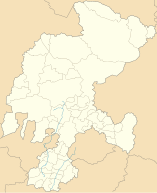Guadalupe (Zacatecas)
| Guadalupe | ||
|---|---|---|
|
Coordinates: 22 ° 45 ′ N , 102 ° 31 ′ W Guadalupe on the map of Zacatecas
|
||
| Basic data | ||
| Country | Mexico | |
| State | Zacatecas | |
| Municipio | Guadalupe | |
| City foundation | 1578 | |
| Residents | 124,623 (2010) | |
| City insignia | ||
| Detailed data | ||
| surface | 24.3 km 2 | |
| Population density | 5,129 inhabitants / km 2 | |
| height | 2315 m | |
| Post Code | 98600 | |
| Website | ||
| Guadalupe - Church of Nuestra Señora de Guadalupe | ||
| Guadalupe - Church of the ex-Hacienda San Bernárdez | ||
| Guadalupe - Church of Nuestra Señora del Rosario | ||
Guadalupe (officially Villa de Guadalupe de Rodríguez ) is a city in the northern Mexican state of Zacatecas with around 150,000 inhabitants . The municipality of the same name ( municipio ) has around 220,000 inhabitants. The Camino Real de Tierra Adentro, recognized by UNESCO as a World Heritage Site , is very close by . In 2018 the historic center of the city of Guadalupe was added to the list of Pueblos Mágicos for its colonial heritage .
Location and climate
The city of Guadalupe is located about 585 km (driving distance) northwest of Mexico City at an average altitude of about 2315 m ; the provincial capital Zacatecas is only about 10 km to the west. The climate is warm; the overall rather sparse rain (approx. 390 mm / year) falls mainly in the summer half-year.
Population development
| year | 2000 | 2005 | 2010 |
| Residents | 78,879 | 99,572 | 124,623 |
The steady population growth is mainly due to the ongoing immigration of individuals and families from the surrounding villages. The population consists mainly of Indians and mestizos ; they mostly speak Spanish.
economy
Silver, copper, lead and zinc ores have been mined in the Zacatecas mines for centuries. The miners and the gradually developing urban population had to be supplied with food and so cattle breeding (cattle, sheep, goats, pigs) began to play an important role in the life of the community; In addition, the cultivation of grain (maize, wheat, barley) and the cultivation of fruits and vegetables (beans, chillies, tomatoes, prickly pears, peaches, pears, figs, walnuts) are important. Small traders, artisans and service providers of all kinds have settled in the neighboring cities of Zacatecas and Guadalupe.
history
At the time of the conquest by the Spaniards (conquista) , the areas in northern New Spain were only sparsely populated by hunting Indians; There were no permanent houses, stone temples or even urban structures. The area was called Huertas de Melgar by the Spanish . The city of Guadalupe emerged gradually to secure the "Silver Road" ( Camino Real de Tierra Adentro ) between Mexico City and the mines of the north.
Attractions
- The largest and most beautiful church in the city is the church, which was built by the Franciscan order at the beginning of the 18th century and belongs to the Colegio Apostólico de Propaganda Fide de Nuestra Señora de Guadalupe , whose façade is still reminiscent of the Baroque , whereas inside clear classical influences are already visible.
- The former monastery complex also has a library (Biblioteca Virreinal) with numerous works on the history of proselytizing in the north of the Viceroyalty of New Spain .
- Parts of the former monastery buildings house the Museo de Guadalupe , which is important beyond the region and mainly presents works of religious art, including a cycle of paintings on the life of St. Francis of Assisi .
- The outer walls of the church of the ex-Hacienda San Bernárdez were originally only stabilized by buttresses ; However, this was not enough and so some powerful buttress arches were added. The portal shows a multi-pass arch borrowed from Moorish architecture .
- The Nuestra Señora del Rosario Church is a building from the mid-20th century.
Personalities
- Antonio Margil de Jesús (1657–1726), Franciscan, founded numerous missionary monasteries in New Spain, including the Colegio Apostólico de Propaganda Fide de Nuestra Señora de Guadalupe .
- José María Rodríguez († 1814) was a regional leader of the independence fighters (insurgentes) at the beginning of the 19th century; he was executed on October 3, 1814.
Web links
- Guadalupe - Photos + Info (Spanish)
- Guadalupe, Tourism - Photos + Info (Spanish)
- Guadalupe, Tourism - Photos + Info (Spanish)



